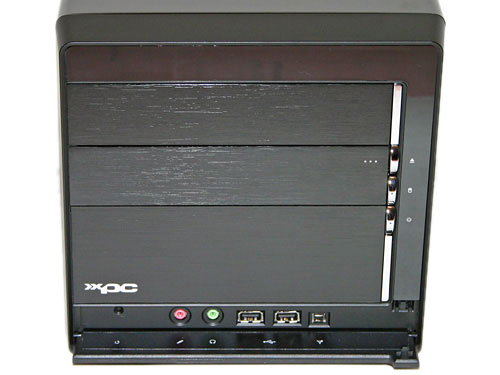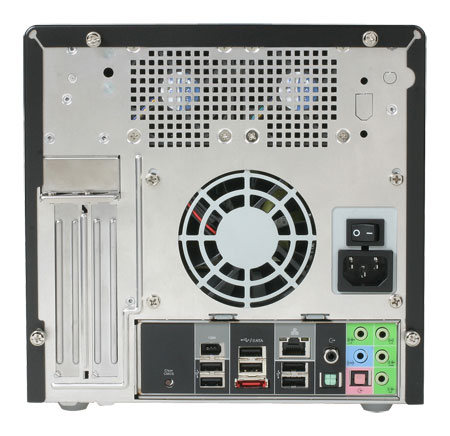Shuttle SN27P2 SFF: AM2 gets the Tiny Treatment
by Jarred Walton on June 30, 2006 11:00 PM EST- Posted in
- Systems
Aesthetics
Beginning with the outward appearance, the SN27P2 is similar to the SN25P, but it does make some changes to the P series chassis. The sides and rear are essentially unchanged, so we will focus our discussion of what's new to the front panel.

There are quite a few changes to the front panel, and they range from the subtle to the immediately noticeable. One thing that we immediately noticed is that the integrated flash memory reader of the older P series is no longer present. If you need/want a flash memory reader, then this is the one change that is clearly a step backwards. However, other options for flash memory readers exist, with the best candidate being a floppy disk/flash memory reader combo drive. Some LCD monitors also come with integrated flash memory readers, so the omission certainly isn't the end of the world.

The P2 chassis can be seen as something of a middle ground between the G5 and P series chassis. The plastic façade of the P series is no more, and the drive bay doors now have brushed aluminum covers. The horizontal gaps and silver accents of the P series have also been removed, along with the round power/reset buttons and LEDs. The new P2 case has a vertical silver stripe that contains the power button, hard drive activity light, and DVD eject button. (Note that the reset switch is now under the bottom flap on the front and will require a pen or similar object to depress.) Overall, the new front panel has a more classy/subdued look. Most people preferred the G5 front panel to the P series panel, and overall we would say the appearance changes are for the better.

If you didn't like the look of the previous Shuttle XPC designs, it's unlikely that you will care too much about the changes, but we've always felt Shuttle's designs are among the most attractive cases on the market. The P2 design continues the trend and offers a sleek looking black case. About the only minor complaint we can levy is that some people might not like the glossy black plastic border on the front panel. The matte black paint job on the SN26P was also better looking overall, but you can always paint the shell on your own if that's a concern.
Beginning with the outward appearance, the SN27P2 is similar to the SN25P, but it does make some changes to the P series chassis. The sides and rear are essentially unchanged, so we will focus our discussion of what's new to the front panel.

There are quite a few changes to the front panel, and they range from the subtle to the immediately noticeable. One thing that we immediately noticed is that the integrated flash memory reader of the older P series is no longer present. If you need/want a flash memory reader, then this is the one change that is clearly a step backwards. However, other options for flash memory readers exist, with the best candidate being a floppy disk/flash memory reader combo drive. Some LCD monitors also come with integrated flash memory readers, so the omission certainly isn't the end of the world.

The P2 chassis can be seen as something of a middle ground between the G5 and P series chassis. The plastic façade of the P series is no more, and the drive bay doors now have brushed aluminum covers. The horizontal gaps and silver accents of the P series have also been removed, along with the round power/reset buttons and LEDs. The new P2 case has a vertical silver stripe that contains the power button, hard drive activity light, and DVD eject button. (Note that the reset switch is now under the bottom flap on the front and will require a pen or similar object to depress.) Overall, the new front panel has a more classy/subdued look. Most people preferred the G5 front panel to the P series panel, and overall we would say the appearance changes are for the better.

If you didn't like the look of the previous Shuttle XPC designs, it's unlikely that you will care too much about the changes, but we've always felt Shuttle's designs are among the most attractive cases on the market. The P2 design continues the trend and offers a sleek looking black case. About the only minor complaint we can levy is that some people might not like the glossy black plastic border on the front panel. The matte black paint job on the SN26P was also better looking overall, but you can always paint the shell on your own if that's a concern.










17 Comments
View All Comments
Calin - Monday, July 3, 2006 - link
Most any ATX case will be quiter and possibly cooler inside than one of those SFF computers. However, they will be twice as big (or more). If that's ok with you, that's great - ATX all the way. If not, a laptop or a SFF certainly makes sense (even if the price is much better on the full ATX front).JarredWalton - Monday, July 3, 2006 - link
I don't know - it depends on the ATX case you're talking about and how many fans you want to install. If you install two or three case fans (or more) and they aren't temperature controlled, a lot of the less expensive ATX cases will be louder than many SFF cases. Lower quality power supplies will also make a lot of noise. If you don't want a big case, and you are interested in getting an extremely easy to set up bare-bones system, SFF computers are really very nice.I do wish prices were about $100 lower, however. $300 for a SFF I can justify; $400+ is a lot more difficult to stomach. For that much money, you can get a good power supply, motherboard, and pretty much any case that you want. I suppose part of it has to do with economies of scale; I don't know how many SFF cases Shuttle has sold, but I doubt they sell as many SFFs someone like ASUS would sell motherboards. That means all of their R&D costs that go into creating a smaller case have to be passed on as a larger percentage of the price.
JarredWalton - Saturday, July 1, 2006 - link
There was no opinion given on which CPU to choose, was there? I simply stated (and this is the expanded version) that even if you're going to buy AMD anyway and couldn't care less about Core 2 Duo, AMD has price cuts scheduled for July 24th so you can pick up an X2 CPU for a lot less than current prices. Here's my opinion:Core 2 Duo will be faster than anything AMD has to offer at least in the short term. AMD X2 will cost less at most (all?) price points, and in some cases (gaming), you're probably GPU limited either way since the current maximum for an SFF is going to be the 7950 GX2. I expect Shuttle will have the SD37P2 out some time after C2D launches, but since they're already 1 month behind the AM2 launch and you still can't purchase the SN27P2, that trend will likely continue and the SD37P2 won't be available until probably early September or so. (I could very well be wrong on that account, but I'm simply going by recent history.)
Which is the better choice? As you have so clearly demonstrated, that's a matter of personal taste. Some people are only going to buy AMD at present; others will only buy Intel. Most would like to buy whichever offers the best performance at a specific price point. I would guess that AMD will be competitive in the price/performance area even if C2D is faster overall, so in the end they get what they're happy with. I still wouldn't purchase an AM2 chip until those price cuts take affect.
VooDooAddict - Saturday, July 1, 2006 - link
Simply.
Will the 7950 Fit?
Does the BIOS support the card?
Can the powersupply keep it running with 2 gigs of RAM and a AMD 5000+?
As soon as I saw the 7950 anouncement all I could think about was building a new SFF system around it.
JarredWalton - Saturday, July 1, 2006 - link
I don't have one available, but my understanding is just about any motherboard with an X16 slot will work with the 7950 GX2. Since I managed to install a 7900 GTX in the SN37P2, I'm pretty sure the GX2 is actually a bit smaller overall, so it will certainly fit. Is it compatible? Well, the SN27P2 uses an NVIDIA chipset, so if it's *not* compatible, NVIDIA has a serious problem with support of GX2. In other words, I'm 99% certain that it will work.VooDooAddict - Monday, July 3, 2006 - link
I didn't think the issue was the chipset ... I thought it was the BIOS.JarredWalton - Monday, July 3, 2006 - link
Right, the BIOS needs to support non-graphics devices in the X16 slots. My point is that if a board using NVIDIA's chipset doesn't support NVIDIA's top GPU, what's the chance of getting everyone else to support it?